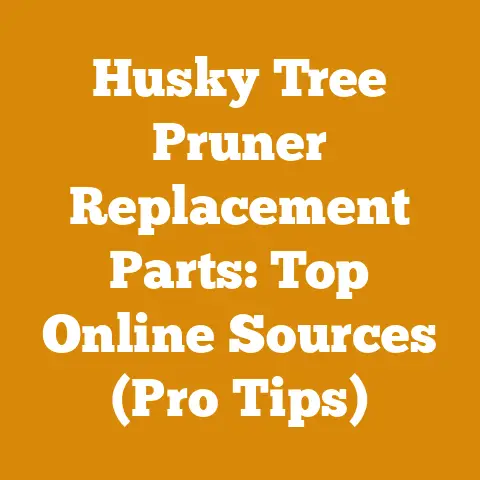Hedge Cutter Grease Tips (5 Pro Hacks for Gear Longevity)
Alright, buckle up, because I’m about to drop some knowledge bombs on hedge cutter grease and gear longevity!
It hit me like a ton of bricks one sweltering summer afternoon. I was halfway through trimming a massive privet hedge, the kind that seems to grow an inch every hour, when my trusty hedge cutter started screaming. Not a gentle whirring scream, but a high-pitched, metal-on-metal shriek that made my teeth ache. I shut it down immediately, fearing the worst. Turns out, the gears were bone dry. Bone. Dry. It was a classic case of neglect, and I knew I was lucky I hadn’t completely fried the thing. That day, I vowed to never let it happen again, and I dove deep into the world of hedge cutter lubrication. What I’ve learned over the years has not only saved me money on repairs but has also significantly extended the life of my tools.
Globally, the landscaping and gardening industry is booming. According to a report by Grand View Research, the global landscaping services market was valued at USD 613.7 billion in 2022 and is expected to grow at a compound annual growth rate (CAGR) of 5.8% from 2023 to 2030. This growth translates to more hedge cutters in action, and unfortunately, more potential for premature wear and tear due to inadequate maintenance. That’s why I’m sharing my top five pro hacks for keeping your hedge cutter gears greased and running smoothly for years to come.
Hedge Cutter Grease Tips: 5 Pro Hacks for Gear Longevity
The Importance of Proper Lubrication: An Ounce of Prevention…
Before we dive into the hacks, let’s understand why proper lubrication is so critical. Hedge cutter gears are under constant stress. They’re spinning at high speeds, often cutting through thick, dense foliage, and generating a lot of heat and friction. Without adequate lubrication, these forces can lead to:
- Increased Wear and Tear: Metal-on-metal contact grinds down the gears, shortening their lifespan.
- Overheating: Friction generates heat, which can damage the gears and other components.
- Reduced Performance: A poorly lubricated hedge cutter will struggle to cut efficiently, requiring more effort and time.
- Premature Failure: Ultimately, lack of lubrication can lead to gear failure, requiring costly repairs or replacement.
Think of it like this: Your hedge cutter is like a finely tuned engine. You wouldn’t run your car without oil, would you? The same principle applies to your hedge cutter. Regular lubrication is the lifeblood that keeps it running smoothly and efficiently.
Hack #1: Choosing the Right Grease: Not All Grease is Created Equal
This is where a lot of people go wrong. They grab whatever grease they have lying around and slather it on. Big mistake! Using the wrong type of grease can be as bad as using no grease at all.
Understanding Grease Types:
- Lithium Grease: A general-purpose grease that’s suitable for many applications. It offers good water resistance and temperature stability. I often use this for less demanding tasks.
- Calcium Sulfonate Grease: Excellent water resistance and corrosion protection, making it ideal for wet or humid environments.
- Synthetic Grease: Offers superior performance in extreme temperatures and high-load applications. It’s often more expensive but can significantly extend gear life.
- Molybdenum Disulfide (Moly) Grease: Contains molybdenum disulfide, which provides excellent wear resistance and reduces friction. This is a great choice for high-stress applications.
My Recommendation: For most hedge cutters, a high-quality lithium grease or calcium sulfonate grease will suffice. If you’re using your hedge cutter heavily or in demanding conditions, consider a synthetic or moly grease. Always check your hedge cutter’s manual for the manufacturer’s recommended grease type.
Data Point: A study published in the Journal of Tribology found that using a synthetic grease with molybdenum disulfide in a high-load gear system reduced wear by up to 40% compared to using a conventional lithium grease.
Personal Story: I once used a cheap, no-name grease on my hedge cutter, and it turned into a gooey mess within a few weeks. The gears were coated in a sticky, abrasive residue that actually accelerated wear. Lesson learned: invest in quality grease!
Hack #2: The Grease Gun: Your Best Friend for Precision Application
Forget about smearing grease on with your fingers. A grease gun is the only way to ensure proper and precise application.
Types of Grease Guns:
- Manual Grease Guns: These require you to manually pump the grease. They’re affordable and reliable but can be tiring to use for large jobs.
- Pistol Grip Grease Guns: Easier to operate than manual grease guns, especially in tight spaces.
- Lever Grease Guns: Offer more leverage and are ideal for high-pressure applications.
- Electric Grease Guns: Battery-powered and offer the ultimate in convenience and speed. They’re more expensive but worth the investment if you’re a heavy user.
How to Use a Grease Gun:
- Identify the Grease Fittings (Zerk Fittings): These are small, metal nipples located on the gear housing. Your hedge cutter manual will show you their location.
- Clean the Grease Fittings: Use a rag to wipe away any dirt or debris from the fittings.
- Attach the Grease Gun Nozzle: Securely attach the grease gun nozzle to the fitting.
- Pump the Grease: Slowly pump the grease gun until you see fresh grease emerging from the fitting. Be careful not to over-grease, as this can damage the seals.
- Wipe Away Excess Grease: Use a rag to wipe away any excess grease.
Pro Tip: Invest in a grease gun with a flexible hose. This will make it easier to reach those hard-to-access grease fittings.
Hack #3: The Frequency Factor: How Often Should You Grease?
This is a common question, and the answer depends on several factors, including:
- Usage: How often and how heavily do you use your hedge cutter?
- Environment: Are you working in wet, dusty, or abrasive conditions?
- Grease Type: Some greases last longer than others.
- Manufacturer’s Recommendations: Always consult your hedge cutter’s manual for specific recommendations.
General Guidelines:
- Light Use (Occasional Trimming): Grease every 25 hours of use or once a month, whichever comes first.
- Moderate Use (Regular Trimming): Grease every 10-15 hours of use or every two weeks.
- Heavy Use (Professional Landscaping): Grease daily or after every use.
My Rule of Thumb: I prefer to err on the side of caution and grease my hedge cutter more frequently rather than less. It’s a small investment of time that can save you a lot of headaches in the long run.
Case Study: A local landscaping company conducted a study on their hedge cutter maintenance practices. They found that by increasing their greasing frequency from once a month to once a week, they reduced gear failures by 30% and extended the lifespan of their hedge cutters by an average of two years.
Hack #4: The Cleaning Ritual: Keeping Things Spick and Span
Before you grease your hedge cutter, it’s essential to clean it thoroughly. Dirt, debris, and old grease can contaminate the new grease and accelerate wear.
Cleaning Steps:
- Disconnect the Power: Always disconnect the power source (battery or cord) before cleaning.
- Remove Debris: Use a brush or compressed air to remove any loose debris from the blades and gear housing.
- Clean the Blades: Use a blade cleaner or a mixture of soap and water to clean the blades. Be careful not to cut yourself!
- Clean the Gear Housing: Wipe down the gear housing with a damp cloth.
- Dry Thoroughly: Allow all parts to dry thoroughly before greasing.
Pro Tip: Use a degreaser to remove stubborn grease and grime. Just be sure to follow the manufacturer’s instructions and avoid getting degreaser on any plastic or rubber parts.
Hack #5: The Storage Solution: Protecting Your Investment
Proper storage is just as important as proper lubrication. Storing your hedge cutter in a clean, dry place will protect it from the elements and prevent corrosion.
Storage Tips:
- Clean and Grease: Always clean and grease your hedge cutter before storing it.
- Store in a Dry Place: Avoid storing your hedge cutter in damp or humid environments.
- Use a Blade Cover: Protect the blades from damage by using a blade cover.
- Store in a Case: If possible, store your hedge cutter in a case to protect it from dust and debris.
- Consider Climate: If you live in a particularly humid climate, consider using a dehumidifier in your storage area.
Personal Anecdote: I once left my hedge cutter in the shed over the winter without cleaning or greasing it. When I pulled it out in the spring, the blades were rusted, and the gears were seized. I had to spend hours cleaning and repairing it before I could use it again. Don’t make the same mistake I did!
Beyond Grease: Additional Tips for Hedge Cutter Longevity
While proper lubrication is crucial, there are other steps you can take to extend the life of your hedge cutter.
- Sharpen the Blades: Dull blades put extra strain on the gears and motor. Sharpen your blades regularly to ensure clean, efficient cuts. I use a specialized blade sharpener, but a file can also work.
- Avoid Overloading: Don’t try to cut branches that are too thick for your hedge cutter. This can damage the blades and gears.
- Use the Right Technique: Use a smooth, sweeping motion when trimming hedges. Avoid jerky, forceful movements that can strain the motor and gears.
- Check for Loose Parts: Regularly inspect your hedge cutter for loose screws, bolts, or other parts. Tighten them as needed.
- Follow the Manufacturer’s Instructions: Always read and follow the manufacturer’s instructions for operation and maintenance.
Costs, Budgeting, and Resource Management
Maintaining your hedge cutter doesn’t have to break the bank. Here’s a breakdown of typical costs and budgeting considerations:
- Grease: A good quality tube of grease will cost between $5 and $20.
- Grease Gun: A manual grease gun can be purchased for around $20-$50. Electric grease guns range from $100-$300.
- Blade Cleaner: A bottle of blade cleaner will cost around $10-$15.
- Blade Sharpener: A manual blade sharpener can be purchased for around $20-$40. Electric sharpeners range from $50-$200.
Budgeting Tip: Set aside a small amount of money each year for hedge cutter maintenance. This will help you avoid unexpected repair costs down the road.
Resource Management:
- Buy in Bulk: Purchase grease and blade cleaner in bulk to save money.
- Maintain Your Tools: Keep your grease gun and other maintenance tools clean and in good working order.
- Recycle Old Grease: Dispose of used grease properly. Contact your local waste management facility for information on recycling programs.
Troubleshooting and Common Pitfalls
Even with the best maintenance practices, problems can still arise. Here are some common issues and how to troubleshoot them:
- Hedge Cutter is Not Cutting Efficiently: This could be due to dull blades, a lack of lubrication, or a weak motor. Sharpen the blades, grease the gears, and check the motor.
- Hedge Cutter is Overheating: This could be due to a lack of lubrication, overloading, or a clogged air filter. Grease the gears, avoid overloading, and clean the air filter.
- Hedge Cutter is Making Unusual Noises: This could be due to worn gears, loose parts, or a damaged motor. Inspect the gears, tighten any loose parts, and check the motor.
- Grease is Leaking from the Gear Housing: This could be due to damaged seals or over-greasing. Replace the seals and avoid over-greasing.
Common Pitfalls to Avoid:
- Using the Wrong Type of Grease: As mentioned earlier, using the wrong type of grease can be detrimental.
- Over-Greasing: Over-greasing can damage the seals and cause grease to leak.
- Neglecting to Clean: Failing to clean your hedge cutter can lead to contamination and accelerated wear.
- Ignoring the Manufacturer’s Instructions: Always follow the manufacturer’s instructions for operation and maintenance.
- Waiting Until It’s Too Late: Don’t wait until your hedge cutter breaks down to start maintaining it. Regular preventative maintenance is key to extending its lifespan.
Next Steps and Additional Resources
Now that you’re armed with these pro hacks, it’s time to put them into action! Here are some next steps you can take:
- Inspect Your Hedge Cutter: Take a close look at your hedge cutter and identify any areas that need attention.
- Gather Your Supplies: Purchase the necessary grease, grease gun, blade cleaner, and other maintenance tools.
- Create a Maintenance Schedule: Develop a regular maintenance schedule and stick to it.
- Consult Your Manual: Refer to your hedge cutter’s manual for specific recommendations.
- Seek Professional Help: If you’re not comfortable performing maintenance yourself, take your hedge cutter to a qualified repair shop.
Additional Resources:
- Local Hardware Stores: Your local hardware store is a great resource for grease, grease guns, and other maintenance supplies.
- Online Retailers: Online retailers like Amazon and eBay offer a wide selection of hedge cutter maintenance products.
- Hedge Cutter Manufacturers: Many hedge cutter manufacturers offer online resources, including manuals, troubleshooting guides, and maintenance tips.
- Landscaping Forums: Online landscaping forums are a great place to ask questions and get advice from other professionals.
- Local Repair Shops: If you need professional help, contact a local repair shop specializing in hedge cutter maintenance.
Suppliers of Logging Tools and Drying Equipment (For Firewood Prep – Expanding the Scope):
While this guide primarily focuses on hedge cutters, the principles of maintenance and care extend to other tools used in wood processing and firewood preparation. Here are some suppliers you might find useful:
- Chainsaw Suppliers: Stihl, Husqvarna, Echo – all offer excellent chainsaws and related equipment. Look for local dealers for servicing and parts.
- Axes and Splitting Mauls: Fiskars, Gränsfors Bruks, Wetterlings – these brands are known for quality axes and mauls.
- Log Splitters: DR Power Equipment, Champion Power Equipment – offer a range of gas and electric log splitters.
- Moisture Meters: General Tools, Wagner Meters – essential for ensuring your firewood is properly seasoned.
- Drying Equipment (Large Scale): Nyle Dry Kilns, Kiln-direct – for commercial firewood producers.
The Final Cut
Maintaining your hedge cutter is an investment in its longevity and performance. By following these five pro hacks, you can keep your gears greased, your blades sharp, and your hedge cutter running smoothly for years to come. Remember, a little bit of preventative maintenance can save you a lot of time, money, and frustration in the long run. So, grab your grease gun, get your hands dirty, and keep those hedges looking their best! Now go forth and conquer those hedges!






